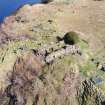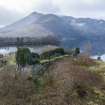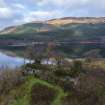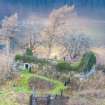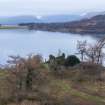Eilean Munde, St Mund's Chapel
Architectural Fragment(S) (Medieval), Church (Medieval), Grave Slab(S) (Medieval) - (Post Medieval)
Site Name Eilean Munde, St Mund's Chapel
Classification Architectural Fragment(S) (Medieval), Church (Medieval), Grave Slab(S) (Medieval) - (Post Medieval)
Alternative Name(s) Loch Leven, Eilean Munde, St Munn's Old Parish Church, Grave-slabs
Canmore ID 23541
Site Number NN05NE 1
NGR NN 0831 5911
Datum OSGB36 - NGR
Permalink http://canmore.org.uk/site/23541
- Council Highland
- Parish Lismore And Appin (Lochaber)
- Former Region Highland
- Former District Lochaber
- Former County Argyll
EILEAN MUNDE (St. Munda's Isle, after St. Fintan Mundus who founded a church here in the 7th century). Burial ground shared by the Camerons of Callart, the Stewarts of Ballachulish and Ardsheal, and the Macdonalds of Glencoe, with some good surviving gravestones. Ruinous church, burnt out 14 95; repaired 16th century and in use until c.1653.
Taken from "Western Seaboard: An Illustrated Architectural Guide", by Mary Miers, 2008. Published by the Rutland Press http://www.rias.org.uk
NN05NE 1.00 0831 5911.
NN05NE 1.01 Centred NN 0831 5910 Burial Ground
(NN 0831 5911) St Munn's Church (NR) (remains of) (NAT)
OS 1:10,000 map, (1975)
At the west end of Eilean Munde are the ruins of the old parish church of Elanmunde, a former parish which served, on the south side of Loch Leven, Glencoe, and parts of Appin, and on the north side, the Inverness-shire districts of Onich and Mamore. The church measures 15.2 metres E-W by 4.9 metres transversely within walls 0.9 metres thick. Although now ruinous and ivy-covered, the east gable and south wall are fairly entire, and the other two walls still stand to a height of about 1 metre above the present floor level which, however, has been considerably raised by burials and is probably about 1 metre above the original ground level. The ground level outside the church has also risen to a similar extent. The church generally corresponds very closely in plan and dimensions with the former parish church of Inishail (NN02SE 2) and can be ascribed to the same period. The entrance doorway is situated toward the west end of the south wall. Two carved stones are built into the north wall towards it east end and probably derive from an earlier church standing on this site.
The whole area was eventually absorbed into the parish of Lismore and the church of Elanmunde abandoned, the last service being held there in July 1653. The dedication was evidently to St Munn. Two medieval carved funerary slabs are to be seen inside the church ruin whilst a number of post-Reformation slabs are to be found both in the church and in the burial ground outside. The burial ground is still in use as such.
RCAHMS 1975, visited August 1970.
As described above.
Surveyed at 1:10 000 scale.
Visited by OS (R L) 13 May 1970.
Field Visit (August 1970)
Old Parish Church and Burial-ground, Eilean Munde.
The church stands at the W end of the island and measures 15.2m from E to W by 4.9m transversely within walls some 0.9m in thickness (Fig. 120, Pl. 24c). The building is ruinous and much overgrown with ivy, but the E gable and S wall are fairly entire, while the remaining two walls stand to an average height of about 1.0 m above the present floor-level. The floor has been considerably raised by burials, however, and must now lie up to 1'0m above the original level, while the ground level outside the church has risen to a similar extent. The building is constructed of local rubble roughly brought to courses, and well bonded with pinnings and coarse lime mortar. Many of the rubble blocks are of large size, and some are set on edge. The quoins and dressings are of buff-coloured sandstone, but some of these have been robbed. The NW and NE quoins have evidently been made good following the removal of the original dressings. These, and some other minor alterations apart, the building appears to be homogeneous, but in the absence of any closely dateable features its age is uncertain. In all probability, however, it is of late medieval date, and it corresponds very closely in plan and dimensions with the former parish-church of Inishail (No. 247 [Canmore ID 23456]), which can be ascribed to the same period.
The entrance-doorway (Pl. 24C) is situated towards the W end of the S wall and comprises a plain lintelled opening wrought on the jambs with an 0.05m chamfer. This doorway was probably raised in height by about 0.48 m during the 17th century, following the raising of the internal floor-level by burials. Towards the E end of the S wall there are the remains of two splayed single· light windows now lacking their heads and all external dressings. The E gable-wall incorporates two put-log holes, which seem to penetrate almost the full thickness of the wall, together with a small aumbry, now at floor level. The N wall has no recognizable openings, but a breach in the masonry towards the Wend may represent the position of a former window. Two carved stones in secondary use are built into the N wall towards its E end. One of these is a window-sill having a daylight-opening of about 0'20 m and a steeply-weathered sill. The other shows traces of a roll-and-hollow moulding. Both fragments are of buff-coloured sandstone, similar to that used for the other dressings, and probably derive from an earlier church standing on the same site.
This church served the former parish of Elanmunde, which comprised, on the N side of Loch Leven, the districts of Mamore and Onich, lying in Invernessshire, and, on the S side of Loch Leven, Glencoe and part of Appin, lying in Argyll. The parish seems to have continued in existence until about the middle of the 17th century, when the Inverness-shire districts were annexed to the parish of Kilmalie. At the same time it was proposed to unite those portions of Elanmunde lying within Argyll with the remainder of Appin (then forming part of the parish of Lismore), to form a separate parish, to be served by a newly erected church at Duror. This scheme was not realized, and the whole area was absorbed within the parish of Lismore, but the church of Elanmunde was abandoned, the last service there being held in July 1653 (en.1). When Bishop Forbes visited the place in 1770 he reported that all four walls of the church were still entire (en.2). The island has continued to be used as a burial-place by the local inhabitants on both sides of Loch Leven. The dedication was evidently to St Munn.
A detailed description of nine medieval and post-reformation funerary monuments is also given, along with a note on a carved stone dated 1705.
RCAHMS 1975, visited August 1970
En.1 Origines Parochiales, ii, part i, 170-1; Argyll Synod Minutes, i, 57, 150, 237, 249; Scott, Fasti, iv, 84-5; NSA, vii (Argyll), 223-4; Carmichael, Lismore, 85-6.
En. 2 Forbes, Journals, 310
*The introduction to this volume notes that this building, along with the church at Inishail, may have been built on or about the 16th century (RCAHMS 1975, 25)
Field Visit (August 1970)
FUNERARY MONUMENTS
Medieval
Numbers 1 and 2 are inside the church; number 3 is about 5 m NE of the burial-enclosure of MacDonald of Glencoe [NN 0840 5905].
(1) Tapered slab with bevelled edges, 1.90 m long by 0.50 m wide at the head; the bevel is decorated with a single row of nail-head ornament. At the top of the stone, within a border composed of two plain mouldings, there is a mounted warrior armed with a spear, while below are two pairs of animals and a single-hand sword flanked by double plant-scrolls. (Drummond, Monuments, pl. xciii, I). lona school, 14th-15th century.
(2) Tapered slab, 1.75 m long by 0.44 m wide at the head, broken into two pieces. Within triple plain mouldings there is a sheathed sword with lobated pommel and canted quillons expanded at the ends. To the left of the sword is a double plant-scroll surmounted by a pair of animals, and to the right a sword-belt. In the lower part of the stone are a comb, a pair of shears, and a casket. (Drummond, Monuments, pl. xciii, 2). 14th-15th century.
(3) Tapered slab with pointed foot, 1.90 m long by 0·45 m wide at the head; it is very worn. At the top there may have been an inscribed panel, but no letters are now visible. The rest of the stone, which is bordered by a channel containing paterae, displays a claymore flanked by plant-scrolls. c. 1500-1560.
Post Reformation
Of the following, numbers 4 and 5 lie within the church and the remainder in the burial-ground.
(4) A worn recumbent slab of schist partly covering a stone-lined burial-recess some 1·2 m in depth, within which there may be seen a human skull and other bones. A marginal inscription reads: HEIER LAYS IOHN CAM[E]RO[N] [ ?WHO DEPAR]TED [?THIS LIFE T]HE[ ?DAY OF M]ARCH ANO 1662 I IN THE 51 YE[A]R OF HIS AEGE AND I THIS DONE BY ORDER OF EWO[N]CAMERON HIS SON & MARGRET CAMPBELL HIS SPOUS[E] (en.1). Within the marginal inscription there are the following lines of verse:
THIS MAN WHILE HE LIVED HERE BELOW / WAS ASTEMED BY ALL WHO DID HIM KNOW / HIS VARTH MEAD HIS DEALLINGS CLEAR / WHICH GEANED HIM FRENDS BOTH FAR AND [NEAR] / HE LEAD AN UPRIGHT AND IUST LIFE / HE SHOUNED / AND SLIGHTED FRIVOLOUS STRIFE / TO SUPERIOURS HE GAVE THER DUE / HIS EQUALS FOUND HIM IUST AND TRUE / HE WAS AVERC TO WRONG OR HURT / OR TO DISPISE THE MINNOR SORT / ALL HONEST MEN HE DID BEFREND / TO CONIVE AT VICE HE CULD NOT YEILD / TO WORLDLY RICHES HE WAS NO SLAVE / YET GOD SUFFICENCE [T]O HIM GAVE / HIS NIGH[T]BOURS O[FFTE]N HE COULD [?SEE] / [I]N TIME OF THERE NEEDSESETY / TO C[R]AUE HIS HELP AND HIS ADVIC / TO GIVE THEM BOTH HE WAS NOT NICE / A MAN OF [H]IS [N]ATION SELDOM HATH
BEEN MOR L[AME]NTED AT HIS DEA(T)H.
(5) A recumbent slab of slate (Pl. 24D) commemorating Duncan McKenzie, tenant at North Ballachelish, and his wife Ann Stewart, and commissioned by their grandson, Duncan McKenzie, smith at Laroch. At the foot of the stone there is a relief-carving (PI. 24E) showing McKenzie, arrayed in full Highland costume, in the act of killing a dragoon at the battle of Prestonpans in 1745. Beneath is the inscription: THE FATE OF AN ENGLISH DRAGOON WHO I ATTACKED D. MC. K. AT THE BATTLE OF I PREST. P. WHERE HE FOUGHT UNDER IPRINCE CHARLES STEWART. This stone is evidently of early 19th-century date.
(6) A table-tomb erected in memory of Allan Cameron of Corrychiracha, who died in 1726, by his son Donald Cameron. It bears a shield charged with three bars, for Cameron.
(7) A table-tomb (Pl. 25A) commemorating Anne Cameron, spouse to John Cameron, son to Culchennan, who died in 1756. Beneath the inscription there is an armorial achievement incorporating a shield charged with three bars, within an architectural surround. For crest there is a dexter arm, armoured, holding a sword. A label above bears the motto PRO REGE ET PATRIA (‘For King and Country'). At the base of the slab there is a reversed monogram of the letters J C and A C.
(8) A recumbent slab of slate (Pl. 2 5B) commemorating William Rankin, successively tenant in Inshree and in Carnach, who died in 1800, and his spouse Mary MacInnes. At the base of the slab there are carved the emblems of mortality, and the conventional epitaph: AS RUNS THE GLASS I MAN'S LIFE DOTH PASS I LIFE HOW SHORT I ETERNETY HOW LONG.
(9) A large recumbent slab of slate (Pl. 25C) erected in memory of John Stewart, who died in 1817 aged 18, by his parents, John Stewart and Jean McDougall at Slate Quarry (Ballachulish). In the centre there is a remarkable pseudo-armorial achievement. The shield is charged: on a field or, a fess cheeky surmounted by abend, a cinquefoil in chief. The supporters are: dexter, a wild man bearing a club; sinister, a lion. For crest, upon a (baron's) coronet of four points, there is a dove bearing in its beak an olive branch. The motto is SOLAJUVAT VIRTUS (‘Virtue is the only reward').
CARVED STONE. Built into the wall of the MacDonald of Glencoe burial-enclosure [NN 0840 5905], which stands above the SE shore of the island, there is a triangular pediment (Pl.25D) carved with the monogram initials J MC D and the date 1706. An inscription records that this stone was removed from the gable of John MacDonald's house at Invercoe, which fell in 1893. John MacDonald, 13th of Glencoe, was the eldest son of the chief who was murdered in 1692, and his house is said to have stood upon the site of the one associated with the massacre (en.2).
RCAHMS 1975, visited August 1970
En.1 The person commemorated was perhaps John, elder son of Alan Cameron, 16th of Lochiel, and father of the famous SirEwen Cameron. He married Margaret, daughter of Sir Robert Campbell, 9th of Glenorchy, and pre-deceased his father c. 1632 (Burke's Landed Gentry (18th ed., 1965-72), i, 116; Memoirs of Sir Ewen Cameron of Lochiell, chief of Clan Cameron, Abbotsford and Maitland Clubs (1842), 63). If this identification is correct, the third numeral in the date in the inscription may have been altered by recutting.
En.2 Name Book No. 49, p.15
Measured Survey (1970)
RCAHMS undertook a measured survey of the old parish church on Eilean Munde in 1970. The resultant phased plan was redrawn in ink and published at a reduced scale (RCAHMS 1975, fig. 120).
Aerial Photography (30 January 2024)
Vertical and oblique aerial photographs were captured at Eilean Munde church and burial ground on 30 January 2024 during a period of ideal flying conditions. Images were captured using a DJI Mavic 3 Pro and Hasselblad L2D-20C camera and include 110 overlapping vertical images (DNG/JPG format) and 18 oblique images. No ground control points were recorded. The vertical images were processed using Agisoft Metashape to produce a 10cm resolution model. Visualisations were produced using the Relief Visualisation Toolbox. The original images and derived visualisations were archived in February 2025.
Information from HEs Archaeological Survey (GFG) 13 February 2025.












































